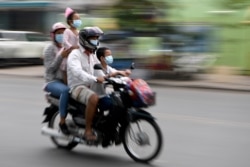Civil society groups and agriculture experts have said that while Cambodia’s food security was not severely impacted by the COVID-19 health crisis, they believe that the contagion should be a wake-up call to strengthen domestic agricultural production and processing capabilities.
As the number of COVID-19 cases started to rise in Cambodia and its two neighbors, Vietnam and Thailand decided to close their borders with the country in late March to prevent the spread of the novel coronavirus. At the time, there was some concern among Cambodians about food availability because a large amount of produce and food products are imported from the two neighbors, especially vegetables and fruits.
Kan Ponharith, a project coordinator of the Voluntary Service Overseas in Cambodia (VSO Cambodia), said the border closure did cause some initial panic among Cambodian citizens, as well as a spike in prices.
“In terms of vegetable production, it was still the same, but during COVID-19, there was a border shutdown, which created some chaotic situation, leading to soaring prices,” said Kan Ponharith.
While initially there was a complete closure of the border, Cambodia did negotiate with both Vietnam and Thailand to allow goods vehicles to cross the border, said Kan Ponharith. He added that measures like swapping drivers at the border, so that no one crossed into the other country, was one of the measures used.
For domestic production, Kan Ponharith said that farmers had already harvested the dry season rice crop by November and when it was time to plant the wet season crop in May the number of cases in Cambodia had levelled off, causing little disruption.
“Therefore, they have enough food in reserve, so it does not affect them much," said Kan Ponharith.
According to the World Bank, Cambodia’s agricultural sector contributes around 22 percent to gross domestic product, with rice production accounting for more than half of Cambodia's agricultural products. In 2019, Cambodia exported 620,000 tons of rice, making it one of the top 10 rice exporters in the world, but still a small fraction of the more than eight million tons of rice produced that year.
However, the country's fruits and vegetables can meet only 70% of local demand, and the rest must be imported, especially from Thailand and Vietnam, according to agriculture statistics compiled by the U.S. Embassy in Cambodia.
Government statistics show that Cambodia imports a large amount of vegetables daily, with 2017 figures pegged at between 200 and 400 tons of vegetables daily. Experts believe the current health crisis is a chance for Cambodian farmers to fill this gap.
Increased food production will also strengthen Cambodia’s nascent food processing industry, especially with crops like cashews and cassava, said Yang Saing Koma, an agriculture expert and founder of the Cambodian Center for Study and Development in Agriculture.
"It is an important lesson for Cambodia to think about strengthening local production to meet the need of the local people,” said Yang Saing Koma, who also heads the Grassroots Democratic Party. “It also helps the economy and creates employment. So, it is an opportunity.”
Yang Saing Koma and Theng Savoeun, who works with farmers’ coalition CCFC, said that nearly two-thirds of Cambodians in the agriculture sector were not entirely dependent on agriculture. They have to rely on extra income from family members who are migrant workers outside their home province or in Thailand, the two experts said.
However, this group is at high risk because some of them have defaulted on their bank loans or microfinance debt because of the dip in manufacturing and migrant workers who have stopped sending remittance because they have had to return home during the pandemic.
"Farmers will risk selling or mortgaging their property to repay microfinance institutions or private banks,” said Theng Savoeun, president of the Coalition of Cambodian Farmers Community (CCFC). "We can say that those who face food shortages will be more vulnerable."
Local government officials have acknowledged the challenges posed by the loss of factory jobs and the return of migrant workers.
“Now the challenge related to the COVID-19 today is that a high number of migrant workers have returned home from Thailand,” Prey Veng Provincial Governor Chea Somethy said at a press conference in July.
However, officials have also painted a rosy picture of the agricultural sector by saying that out-of-work workers can get back to the fields and use machinery to increase yields. Prime Minister Hun Sen has also said agriculture is the best solution for people to avoid the economic slowdown.
“I’d say no matter how large the field is, the work can still be done and yield a surplus. This is because we use machinery,” said Svay Rieng province’s Deputy Governor Ros Pharith at a press conference on July 6.
According to a small survey by VSO Cambodia, which interviewed 382 farmers, 296 farmers said their businesses were unaffected and would be able to scale up to full production in three months, whereas 40 farmers could partially restart production with government assistance.
"Overall, we are now helping the rice sector by linking farmers to the market,” said Kan Ponharith of VSO Cambodia. “We provide them clear information on their rice productions, and link them with rice-mill owners.”








